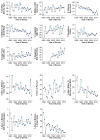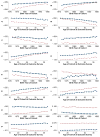Maternal Risk Exposure and Adult Daughters' Health, Schooling, and Employment: A Constructed Cohort Analysis of 50 Developing Countries
- PMID: 27154342
- PMCID: PMC4934894
- DOI: 10.1007/s13524-016-0472-z
Maternal Risk Exposure and Adult Daughters' Health, Schooling, and Employment: A Constructed Cohort Analysis of 50 Developing Countries
Abstract
This study analyzes the relationships between maternal risk factors present at the time of daughters' births-namely, young mother, high parity, and short preceding birth interval-and their subsequent adult developmental, reproductive, and socioeconomic outcomes. Pseudo-cohorts are constructed using female respondent data from 189 cross-sectional rounds of Demographic and Health Surveys conducted in 50 developing countries between 1986 and 2013. Generalized linear models are estimated to test the relationships and calculate cohort-level outcome proportions with the systematic elimination of the three maternal risk factors. The simulation exercise for the full sample of 2,546 pseudo-cohorts shows that the combined elimination of risk exposures is associated with lower mean proportions of adult daughters experiencing child mortality, having a small infant at birth, and having a low body mass index. Among sub-Saharan African cohorts, the estimated changes are larger, particularly for years of schooling. The pseudo-cohort approach can enable longitudinal testing of life course hypotheses using large-scale, standardized, repeated cross-sectional data and with considerable resource efficiency.
Keywords: Cohort analysis; Developing countries; Fertility; Life course; Reproductive health.
Figures




Similar articles
-
Linking mother's demographic disadvantages with children's demographic outcomes in India: a pseudo cohort study.Popul Health Metr. 2025 Jun 16;23(1):27. doi: 10.1186/s12963-025-00384-y. Popul Health Metr. 2025. PMID: 40524148 Free PMC article.
-
A prospective study on some factors which influence the delivery of large babies.J Trop Med Hyg. 1993 Dec;96(6):352-6. J Trop Med Hyg. 1993. PMID: 8254713
-
Are all immigrant mothers really at risk of low birth weight and perinatal mortality? The crucial role of socio-economic status.BMC Pregnancy Childbirth. 2016 Apr 8;16:75. doi: 10.1186/s12884-016-0860-9. BMC Pregnancy Childbirth. 2016. PMID: 27059448 Free PMC article.
-
Determinants of low birth weight: a community based prospective cohort study.Indian Pediatr. 1994 Oct;31(10):1221-5. Indian Pediatr. 1994. PMID: 7875782
-
Impact of family planning programs in reducing high-risk births due to younger and older maternal age, short birth intervals, and high parity.Semin Perinatol. 2015 Aug;39(5):338-44. doi: 10.1053/j.semperi.2015.06.006. Epub 2015 Jul 10. Semin Perinatol. 2015. PMID: 26169538 Review.
Cited by
-
Prevalence and Severity of Molar-Incisor Hypomineralization, Maternal Education, and Dental Caries: A Cross-Sectional Study of Mexican Schoolchildren with Low Socioeconomic Status.J Int Soc Prev Community Dent. 2019 Sep 30;9(5):513-521. doi: 10.4103/jispcd.JISPCD_130_19. eCollection 2019 Sep-Oct. J Int Soc Prev Community Dent. 2019. PMID: 31620386 Free PMC article.
-
Linking mother's demographic disadvantages with children's demographic outcomes in India: a pseudo cohort study.Popul Health Metr. 2025 Jun 16;23(1):27. doi: 10.1186/s12963-025-00384-y. Popul Health Metr. 2025. PMID: 40524148 Free PMC article.
-
Changing self-identification among immigrants in the United States.Front Sociol. 2025 May 9;10:1445287. doi: 10.3389/fsoc.2025.1445287. eCollection 2025. Front Sociol. 2025. PMID: 40415964 Free PMC article.
References
-
- Abu-Saad K, Fraser D. Maternal Nutrition and Birth Outcomes. Epidemiologic Reviews. 2010;32:5–25. - PubMed
-
- Adam I, Ismail MH, Nasr AM, Prins MH, Smits LJ. Low birth weight, preterm birth and short interpregnancy interval in Sudan. Journal of Maternal-Fetal and Neonatal Medicine. 2009;22:1068–1071. - PubMed
-
- Barker DJP. Mothers, babies, and disease in later life. London, UK: Churchill Livingstone; 1994.
-
- Barker DJP, Sheill AW, Barker ME, Law CM. Growth in utero and blood pressure levels in the next generation. Journal of Hypertension. 2000;18:843–846. - PubMed
-
- Black RE, Victora C, Walker SP, Bhutta ZA, Christian P, de Onis M … Maternal and Child Nutrition Study Group. Maternal and child undernutrition and overweight in low-income and middle-income countries. Lancet. 2013;382:417–425. - PubMed
Publication types
MeSH terms
Grants and funding
LinkOut - more resources
Full Text Sources
Other Literature Sources

